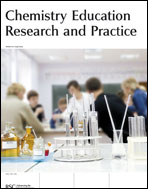Diagnosing changes in attitude in first-year college chemistry students with a shortened version of Bauer's semantic differential
Abstract
In this quantitative study, a shortened version of the Attitude toward the Subject of Chemistry Inventory (ASCI) created by Bauer (2008) was used to identify the chemistry attitudes of two populations of general chemistry students at two universities. The ASCIv2 contained just two factors from the original instrument. These factors measured students' emotional and intellectual attitudes towards chemistry as a subject. Students required only two minutes to respond to ASCIv2, providing a mechanism to use it with additional instruments in a research design while minimizing assessment fatigue. This study used confirmatory factor analysis to provide evidence for the validity of the ASCIv2. The Cronbach's alpha (α) values for both factors at 0.74 or greater at both institutions provided evidence of strong internal consistency in the ASCIv2. This study also confirmed the instrument's sensitivity, i.e., the ability to detect small attitude differences in a student population. Examples discussed include pre- and post-test implementations, along with attitude differences between males and females in general chemistry. Analysis showed a positive relationship between students' attitudes and general chemistry success.
- This article is part of the themed collection: Diagnostic Assessment in Chemistry

 Please wait while we load your content...
Please wait while we load your content...